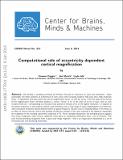| dc.contributor.author | Poggio, Tomaso | |
| dc.contributor.author | Mutch, Jim | |
| dc.contributor.author | Isik, Leyla | |
| dc.date.accessioned | 2015-12-10T23:15:14Z | |
| dc.date.available | 2015-12-10T23:15:14Z | |
| dc.date.issued | 2014-06-06 | |
| dc.identifier.uri | http://hdl.handle.net/1721.1/100181 | |
| dc.description.abstract | We develop a sampling extension of M-theory focused on invariance to scale and translation. Quite surprisingly, the theory predicts an architecture of early vision with increasing receptive field sizes and a high resolution fovea — in agreement with data about the cortical magnification factor, V1 and the retina. From the slope of the inverse of the magnification factor, M-theory predicts a cortical “fovea” in V1 in the order of 40 by 40 basic units at each receptive field size — corresponding to a foveola of size around 26 minutes of arc at the highest resolution, ≈6 degrees at the lowest resolution. It also predicts uniform scale invariance over a fixed range of scales independently of eccentricity, while translation invariance should depend linearly on spatial frequency. Bouma’s law of crowding follows in the theory as an effect of cortical area-by-cortical area pooling; the Bouma constant is the value expected if the signature responsible for recognition in the crowding experiments originates in V2. From a broader perspective, the emerging picture suggests that visual recognition under natural conditions takes place by composing information from a set of fixations, with each fixation providing recognition from a space-scale image fragment — that is an image patch represented at a set of increasing sizes and decreasing resolutions. | en_US |
| dc.description.sponsorship | This work was supported by the Center for Brains, Minds and Machines (CBMM), funded by NSF STC award CCF - 1231216. | en_US |
| dc.language.iso | en_US | en_US |
| dc.publisher | Center for Brains, Minds and Machines (CBMM), arXiv | en_US |
| dc.relation.ispartofseries | CBMM Memo Series;017 | |
| dc.rights | Attribution-NonCommercial 3.0 United States | * |
| dc.rights.uri | http://creativecommons.org/licenses/by-nc/3.0/us/ | * |
| dc.subject | Invariance | en_US |
| dc.subject | Theories for Intelligence | en_US |
| dc.subject | Machine Learning | en_US |
| dc.subject | Vision | en_US |
| dc.title | Computational role of eccentricity dependent cortical magnification | en_US |
| dc.type | Technical Report | en_US |
| dc.type | Working Paper | en_US |
| dc.type | Other | en_US |
| dc.identifier.citation | arXiv:1406.1770v1 | en_US |
